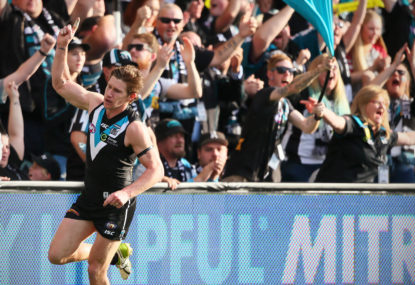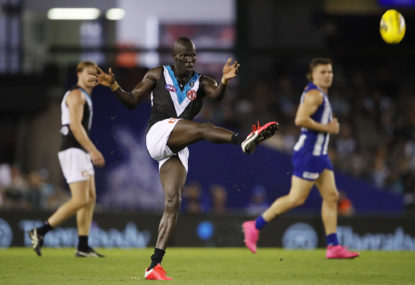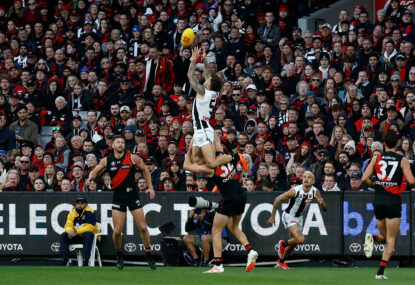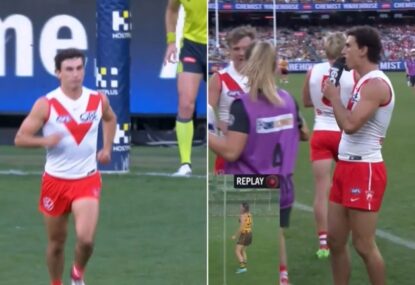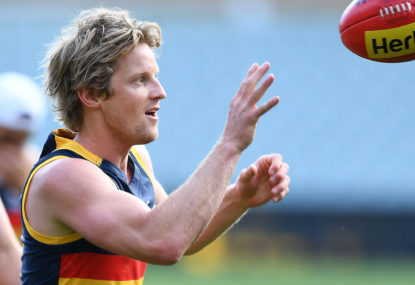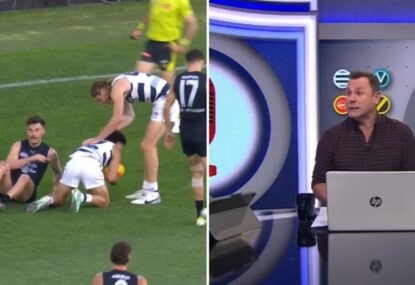The AFL season starts this week, and with a lot of mid-table teams having been active in the trade period, it looks set to be another even year.
Will the Bulldogs back up their breakout year? Can Charlie Dixon cancel out the loss of Patrick Ryder and Angus Monfries? Will Patrick Dangerfield propel Geelong up the ladder or only delay the inevitable fall?
In my predicted ladder, there are only three wins separating sixth (North Melbourne) and 11th (Geelong). Last year we saw Port Adelaide blitz Hawthorn twice, but lose to Carlton and Brisbane to miss the eight. Teams are going to have to take all their chances because competition for spots will again be tight.
The bottom three looks set – Essendon, Carlton and Brisbane. Adelaide’s nightmare draw probably rules them out, they could easily start the year 0-8, while Gold Coast never seem to have their best team on the park.
But apart from those, every other team has a chance of making finals.
So, without further ado, here is my 2016 top eight.
1. Port Adelaide
Almost every season a team shoots into the top four after missing the finals in the previous year. If this tradition is to continue in 2016, Port is the obvious pick.
2015 was a difficult year for the club; niggling injuries and a tough draw meant they never found their groove, but there were some positives – they learnt a lot about their weaknesses, recruited to address them, and unearthed some much-needed depth with Sam Gray and Brendon Ah Chee standing up.
The Power’s game plan relies on having a lot of open space between the midfield and half forward for the smalls to run through, but opposition teams countered this in 2015 by clogging up the defensive half of the field.
The club responded by recruiting key forward target Dixon. The contested-marking forward will add another dynamic to the attack and make the forward line harder to shut down. He will give them the confidence to attack direct through the corridor again, like they did when they burst onto the scene in 2013.
Port is also well placed to deal with the new interchange cap; their list is full of strong runners and midfielders who can rest up forward or down back to great effect. They can set themselves for a high finish on the back of a comfy opening draw, with eight of their first 11 games against teams that missed finals last year.
2. Fremantle
Fremantle finished top after the home-and-away season last year, yet they have still been handed a reasonable draw, with double-up games against Adelaide, Western Bulldogs, Greater Western Sydney and Gold Coast.
Some have question marks over the age of the list, but Matthew Pavlich is still mobile enough to play a role up forward, and Aaron Sandilands will continue to put up big hit-out numbers.
The Dockers don’t have the wealth of young talent that other clubs enjoy, but high draft picks Lachie Weller and Connor Blakely could rejuvenate the team, and Harley Bennell will add some much-needed flair and goal-kicking ability at half forward.
The retired Luke McPharlin was a key player for the Dockers in defence, however the team has already proven they can cover the loss of a tall, with Zac Dawson and Michael Johnson missing for significant periods of last season.
The big question for Fremantle is how they will respond to the new interchange cap, which has been brought in specifically to stop the rolling maul game they love to play. If the cap works as expected and makes the game more open, Fremantle could be shown up.
It’s possible they’ll slip slightly, but Ross Lyon won’t be happy with anything other than a top-four finish.
3. Hawthorn
There’s not much you can say about the Hawks that hasn’t already been said. The three-peat premiers have the chance to cement themselves as the greatest team of the modern era in 2016, but a number of key departures and injuries will make it a more challenging year compared to last.
Where the Hawks finish will depend largely on how well they manage without Jarryd Roughead in the first half of the season. They will be made to earn their wins in the first two weeks, with grudge matches against a revitalised Cats outfit and the grand final replay against West Coast.
The forward line has always been a great strength for the Hawks but the loss of Roughead and the retirement of David Hale means they will lose some potency. It’s hard to see Jack Gunston matching it with some of the bigger defenders and this will have a flow-on effect for the other forwards too.
The Hawks seemed to lack motivation at times last season but flicked the switch in must-win games. Even from fourth spot, if they can keep their older playmakers fit and avoid playing Port Adelaide in the finals, they are as good a chance as anyone to go all the way once again.
4. West Coast
West Coast were 2015’s big movers; with an easy draw and no expectations, they managed to make it all the way to the grand final after finishing outside the eight the previous year.
The Eagles were hit hard by injuries to their defence last year but proved to be an exceptionally well-drilled side that could cover a lack of height through team zoning. With the return of 2014 best and fairest winner Eric Mackenzie and Mitch Brown, they will have a much more versatile backline in 2016.
Jeremy McGovern will be a major wildcard now that he has been freed up from lockdown defensive duties, the contested marking tall can fill a hole at either end of the ground or in the ruck.
A great strength of the Eagles is that they have been able to extract the absolute best out of their players. Matt Priddis and Andrew Gaff are the best examples of this. If they can also get Lewis Jetta playing career-best football it will add another dynamic to the midfield – the ex-Swan speedster will love playing on a wing at Domain Stadium.
A stretch of games against Hawthorn, Fremantle, Richmond and Sydney early on will be a real test, if they can get through it with a 50-50 win-loss ratio they will set their season up nicely.
5. Richmond
Richmond’s form in the back end of 2014 and right through 2015 is hard to ignore, with a 24-8 win-loss record from their last 32 home-and-away games.
Damien Hardwick’s gameplan has proven effective on all grounds and against all teams, delivering wins against Hawthorn at the MCG, Fremantle at Domain, Sydney at the SCG and Port Adelaide at Adelaide Oval last year.
Richmond finished second only to Hawthorn for ball retention in 2015 and their ability to hold onto the ball will serve them well with the new interchange cap; the best way to conserve energy is by keeping possession while the opposition are working overtime to pressure and win the ball back.
The Tigers lost experienced head Chris Newman to retirement at the end of 2015 but added Chris Yarran and Jacob Townsend to the list during the trade period. Both can fill a need in Richmond’s best 22 if they deliver on untapped potential.
Brett Deledio is the barometer for the Tigers, they rarely win without him, and if Trent Cotchin and Dustin Martin can take another step forward they might have the star power to make a move into the top four.
The final third of the year will again be the true test for Richmond; will their uncontested game stand up through the winter months and the pressure of finals?
6. North Melbourne
North would have to be thinking this is their last shot with the current group of players, but until they prove they can consistently beat top opposition, it is hard to justify them as a top-four or premiership chance.
The Roos are a consistently high-scoring team with a great spread of goal kickers, but the defensive side of the game is where they usually come undone. Jed Anderson will help in this regard, apart from being very skilled, he is also quick and loves to tackle. Daniel Wells will add some much-needed x-factor to a blue-collar midfield, but may not play every week.
North have a relatively easy start to the season but from Round 10 onwards they play eight games against projected top eight teams, and no games against projected bottom four teams (Essendon, Carlton, Brisbane, Gold Coast). Their contested game should hold up in the winter months and they are a good chance of stealing a few wins against higher rated opponents.
Todd Goldstein will be the key to their finals push – if the midfielders can capitalise on his dominance against the Sydney and Hawthorn rucks in late season double-up games, they will cement a spot in the eight
7. Collingwood
Collingwood started strongly in 2015 but just couldn’t quite match it with the top teams in the second half of the season, falling short of finals for a second year in a row.
Their midfield is stacked with good attacking players; when they get their hands on the ball in the centre square they are hard to stop, and they run in waves similar to the Port of 2013 or Footscray 2015.
In the off-season the Pies landed one of the biggest names of the trade period, ex-Giant Adam Treloar. Along with the emergence of Jordan De Goey as a clearance player over the pre-season, this gives them the flexibility of having Scott Pendlebury spend time down back, where they have lacked quality line breakers the last two seasons.
They also have a good spread of goal kickers. Darcy Moore should add to last year’s goal tally and Dane Swan will be a handful for opposition defenders when he rests forward thanks to the interchange cap.
The defence still looks shaky, particularly with Ben Reid missing, but reports are he’ll be ready to go for Round 1. Collingwood also play Essendon twice, a potential ‘free’ win and percentage boost over other top-eight hopefuls.
8. Sydney
The Swans have enough midfield talent to supply Lance Franklin and Kurt Tippett that they should hold a top-eight spot, but their fall from the top looks set to continue in 2016.
Sydney has a strong group of inside midfielders, but it was their ‘slingshot’ game style, built around outside runners and good ball users off half back, that elevated them from a hard-working team to premiership contenders in 2012.
When Nick Malceski left at the end of the 2014 season, the club failed to find a suitable replacement. The star half back was the league’s leading rebound 50 player in 2014, and one of the best kicks in the game. Without him the Swans often overused the handball and turned the ball over under pressure. Now they have lost Rhys Shaw and Lewis Jetta too – clearly their next best run-and-carry players.
An AFL-imposed trade ban and draft picks tied to highly rated academy players has made it difficult for the Swans to recruit ready-made replacements for their outside offensive play. They’ll be hoping Dean Towers and Zac Jones can fill the void, but they may have to take a step back before they can be a contender again.
Expect new recruit Callum Mills to play an important role off half back in his first season. A good chance to win the Rising Star award.






























































































